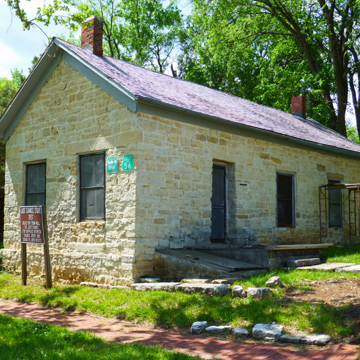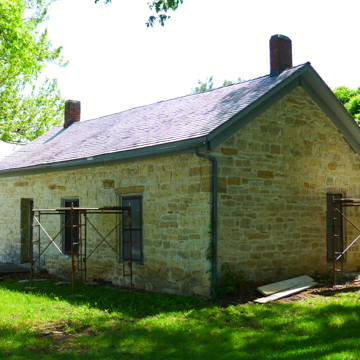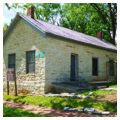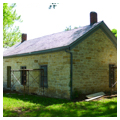The Last Chance Store, located in Council Grove, remains the most tangible and intact reminder of a pivotal time in the settlement of the American West. The town’s name derives from an 1825 meeting along the Neosho River between federal representatives and leaders of the Osage tribe in which free passage was granted through Indian Territory for travelers on the Santa Fe Trail. Because of its strategic location at a key river crossing, Council Grove was where travelers would gather to take on supplies, rest, and form themselves into caravans before continuing their westward journey. It marked the place where travelers left the relative comfort of more verdant and civilized territory for a more challenging passage through arid and unpopulated land.
After the outbreak of the Mexican-American War in 1846, the discovery of gold in California in 1849, and legalization of settlement in Kansas as stipulated in the Kansas–Nebraska Act of 1854, traffic on the trail increased dramatically, and savvy entrepreneurs recognized that there was money to be made catering to the streams of people moving though the area. Because Council Grove was within an area given to the Kaw tribe in 1846, whites wanting to do business in this area needed federal authorization. Seth Hays, who arrived and opened a store in 1847, was the first to gain such authorization. Many of the others who quickly followed ignored the regulation, and a frontier town rapidly emerged.
Tom Hill arrived and started doing business in 1857, selling supplies to travelers headed west on the Santa Fe Trail. To conduct his business, Hill erected a modest, single-story, one-room building made from roughly coursed, locally quarried limestone. The small building located at the western end of Council Grove’s Main Street came to be known as the Last Chance Store because it was literally the last chance for westward bound travelers to purchase manufactured items or processed commodities until they reached Santa Fe some two months later.
Hill’s business thrived in relation to the volume of traffic on the Santa Fe Trail, but over time the stream of travelers through Council Grove dwindled, particularly after the Atchison, Topeka and Santa Fe Railroad extended its service westward. The railroad bypassed Council Grove, and many travelers elected to take the railroad as far west as possible before taking the Santa Fe Trail for the remainder of the trip. Construction of the rail line began in earnest at the end of the Civil War; it reached the Colorado line in 1873 and Santa Fe in 1880. Subsequent rail lines connected Council Grove to the emerging rail grid, and the town continued to prosper as an agricultural center, but by the mid-1870s Council Grove’s hectic times as a key stop on the Santa Fe Trail were over.
When the store closed, the building sat vacant for many years, and received only minimal maintenance. Still, the building survived, with most of the original store fixtures still in place. In the spring of 2015, the Kansas State Historical Society purchased the building with plans to restore it for use as an interpretive center for the Santa Fe Trail. One of six National Historic Landmarks related to the pivotal role of Council Grove, the Last Chance Store remains a vivid reminder of an important chapter in Kansas history.
References
Boundary Review Task Force, “Council Grove National Historic Landmark,” Morris County, Kansas. National Register of Historic Places Inventory-Nomination Form, 1966; updated 1983 by S. Pearce and 1984 by N. Witherell. National Park Service, U.S. Department of the Interior, Washington, D.C.
Pankratz, Richard D., “The Last Chance Store,” Morris County, Kansas. National Register of Historic Places Inventory–Nomination Form, 1971. National Park Service, U.S. Department of the Interior, Washington, D.C.
Spencer Preservation, “Council Grove Downtown Historic District,” Morris County, Kansas. National Register of Historic Places Inventory–Nomination Form, 2009. National Park Service, U.S. Department of the Interior, Washington, D.C.




